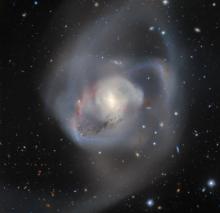Listen to today's episode of StarDate on the web the same day it airs in high-quality streaming audio without any extra ads or announcements. Choose a $8 one-month pass, or listen every day for a year for just $30.
You are here
Milky Way Satellites
Our home galaxy, the Milky Way, is a galactic shepherd. It controls the movements of maybe 60 or more smaller galaxies. They’re satellites of the Milky Way, so they circle around it in the same way that Earth orbits the Sun.
Two of the satellite galaxies are bright enough to see with the eye alone — the Large and Small Magellanic Clouds. The large cloud is the biggest of the satellites.
All of the others are so far, small, and faint that they’re visible only through telescopes. Most of them are no more than puffballs. As a result, most of them weren’t discovered until this century.
The closest may be the Canis Major Dwarf — about 25,000 light-years from Earth. But there’s disagreement about whether it’s a galaxy or just a star cluster.
The closest confirmed satellite is the Sagittarius Dwarf — about 65,000 light-years away. It’s plunged through the Milky Way’s core several times, disrupting the orbits of some of the stars in the bigger galaxy.
The Milky Way’s gravity is pulling the Sagittarius Dwarf apart. Some day, all of its stars will be incorporated into the Milky Way — and a member of the Milky Way’s flock will disappear.
The Sagittarius Dwarf is in the constellation Sagittarius, which is low in the south at nightfall. Its stars form the outline of a teapot. The Sagittarius Dwarf is to the left of the teapot. But it’s veiled by clouds of dust — a hidden satellite of the Milky Way.
Script by Damond Benningfield






